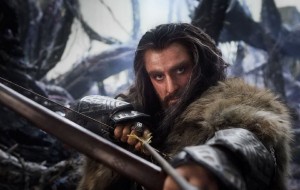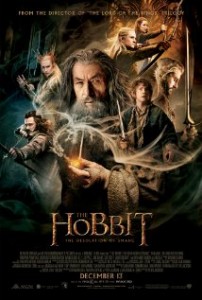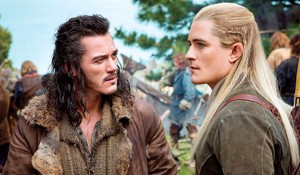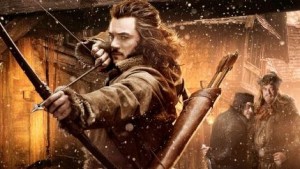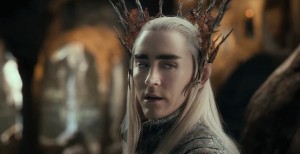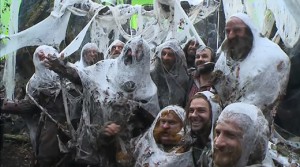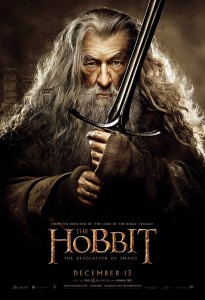The Hobbit: The Desolation of Smaug *** (2013, Ian McKellen, Martin Freeman, Richard Armitage) – Movie Review
Part two of The Hobbit, and Thorin (Richard Armitage) and the dwarves, along with the hobbit Bilbo Baggins (Martin Freeman) and the Wizard Gandalf the Grey (Ian McKellen), continue their quest to reclaim their homeland Erebor from the dragon Smaug. The company must take on the dangers of Mirkwood Forest without Gandalf, who’s inexplicably disappeared.
When they reach the human settlement of Laketown, burglar Bilbo will need to fulfil his part of the bargain with the dwarves. The party must complete the journey to Lonely Mountain and Bilbo, still in possession of a mysterious and magical ring, must seek out the Secret Door that will give them access to the hoard of Smaug. Best not to wake him up, though, as you try to steal his treasure, Bilbo, because he’s a huge, fire-eating monster.
Unfortunately writer-director Peter Jackson and his regular co-writers Fran Walsh and Philippa Boyens have come up with a screenplay that in expanding J R R Tolkien’s beloved original for a three-part franchise betrays it in most every respect. They’ve chucked out the humour and the charm and rewritten most of the story as a CGI-led action blockbuster, with new characters – a woman for heaven’s sake! – and returning ones from Lord of the Rings that have no business being here.
Yes it’s great to see Legolas (Orlando Bloom) again, but what the heck is he doing in The Hobbit? Why are the elves in this story at all? And why, oh why is there a female elvine archer, Tauriel (Evangeline Lilly)? Having shoehorned this character into a story that famously has no female characters, they’ve not bothered to give her any actual character at all. She’s just Legolas in a dress. And an elf fancying a dwarf? I don’t think so! And she simply serves to cramp Bloom’s style.
Come to that Legolas has nothing to do either, other than shoot arrows and run around a lot (though Bloom adds a little to the character with some eyebrow acting of the kind that went out of fashion in Roger Moore’s heyday).
That’s the movie’s game plan. To move as fast as possible from one bit of action to the next, preferably by running. To skim over the wonderful set pieces from Tolkien’s novel, like the encounter with the giant spider or Bilbo’s meeting with Smaug, that beg to crackle with tension, thrill you with witty dialogue and take their time to unravel and work their magic.
It’s all in the book, you don’t need to tamper with it, just film it like it is. Jackson’s got all the time in the world in a two hours 40 minutes running time (that actually feels a lot longer). He can take his time to build suspense and dally over dialogue, but he messes it up nervously like he did in part one, The Hobbit: An Unexpected Journey (2012), with Riddles in the Dark, pruning, cutting and cross-cutting.
The scene with the Secret Door is a case in point. When the dwarves can’t find the secret keyhole, they just give up and leave. Then they mysteriously turn up again just when Bilbo finds the keyhole and Thorin saves the key just as it’s falling off the cliff. It plays like it’s a Laurel and Hardy movie, except without the intentional laughs. This is all clumsy and inept.
It seems Jackson has literally lost the plot, Tolkien’s plot that is, and he’s lost his ability as a great storyteller, lost his control over narrative and character. All he can do is swing his cameras around to find weird angles for an eye-catching shot, bring on more (often quite nasty) battles and fights, and, whenever in doubt, send in the CGI.
The climax, as the dwarves battle the dragon, is incredibly ingenious and busy, but it is just so absurdly overblown and unbelievable that it could only exist in a movie-makers’ computer-generated world, not the world of fairy tales and the imagination.
Acting wise, McKellen is by far the best thing in the movie, a total class act that it completely depends on. When he’s not on screen, the film simply isn’t anything like as good. Armitage is excellent as Thorin, with a lot to do that he does really commandingly well.
Freeman remains miscast as Bilbo. He’s a comedian, and he tries to make Bilbo comic from the outside, whereas an actor would find the truth of the character from the inside. It’s just not enough that he looks like Tolkien’s vision of Bilbo. You’ve only got to compare him with Ian Holm to see how he falls short.
The dwarves all have wacky kinds of looks, but again they have no characters, and that defeats a number of good actors, Ken Stott and James Nesbitt among them, though you’d hardly know, as you can’t find people inside all the makeup.
Stephen Fry does his best with an unsympathetic and again underwritten key role as Master of Laketown, a useful Luke Evans has a lot to do, most of it running around, as a very Welsh Bard, with a Welsh family it seems too, Sylvester McCoy is Radagast and Benedict Cumberbatch is the voice of Smaug. You notice all this along the way, without any of them being particularly distinguished contributions.
Many people wanted Jackson to drop the daft comedy of part 1 this time, and now they’re probably eating their words. This film’s properly serious, but it needs gentle, warm-hearted, good-spirited comedy moments to break up the constant running and battles. But it gets hardly any humour at all.
The Desolation of Smaug looks eye-catchingly good and is busy and fast moving, but it’s never really fun or exciting or Tolkien. It’s like Jackson never quite got Tolkien after all. Perhaps he should have quit while he was ahead with the magnificent achievement of The Lord of the Rings.
Part three followed: The Hobbit: The Battle of the Five Armies (2014).
© Derek Winnert 2013 Movie Review
Check out more reviews on http://derekwinnert.com/

